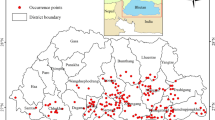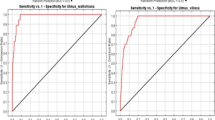Abstract
The Gandaki River Basin (GRB), located in the central Himalaya, provides habitats for a large number of important flora and fauna species. The habitats of key protected species have changed over time as a result of climate changes and human activities related to land use change, including the development of roads. This study assessed the present and future distributions of sloth bear (Melursus ursinus) habitats using the maximum entropy (MaxEnt) model. Bioclimatic data, a digital elevation model and roads were used as environmental layers to assess current and future distributions of habitat. Results show that the overall habitat within the study area is likely to undergo important changes in the future. Bio 8 (the mean temperature of the wettest quarter) and slope were found to be important variables affecting the distribution of the species. The habitats very highly suitable for sloth bears currently cover an area of 148 km2 within the GRB. These habitats are predicted to increase by 122 km2 more by 2050. Overall, a net change by 680.38 km2 was found in the GRB. Conservation measures are necessary for this key protected species and its habitat within the GRB and elsewhere in Nepal.
Similar content being viewed by others
References
Acharya B, Cao C, Xu M, et al. (2018) Present and future of dengue fever in Nepal: mapping climatic suitability by ecological niche model. Int J Environ Res Public Health 15(2): 2–15. https://doi.org/10.3390/ijerph15020187
Akhtar N, Bargali HS, Chauhan N (2004) Sloth bear habitat use in disturbed and unprotected areas of Madhya Pradesh, India. Ursus 15(2): 203–211.
Bargali H, Akhtar N, Chauhan N (2012) The sloth bear activity and movement in highly fragmented and disturbed habitat in central India. W J Z 7(4): 312–319. https://doi.org/10.5829/idosi.wjz.2012.7.4.64180
Beecham JJ, Reynolds DG, Hornocker MG (1983) Black bear denning activities and den characteristics in west-central Idaho. Int Conf Bear Res and Manage 5: 79–86.
Bhandari A, Bagale S, Silwal T, et al. (2020) Spatio-temporal patterns of wildlife attacks on humans in Chitwan National Park, Nepal. SRLS 1(1): 1–20. https://doi.org/10.1371/journal.pone.0195373
Changjun G, Yanli T, Linshan L, et al. (2021) Predicting the potential global distribution of Ageratina adenophora under current and future climate change scenarios. Ecol Evol 11(17): 12092–12113. https://doi.org/10.1002/ece3.7974
Chhetri PK, Gaddis KD, Cairns DM (2018) Predicting the Suitable Habitat of Treeline Species in the Nepalese Himalayas Under Climate Change. MRD 38(2): 153–163. https://doi.org/10.1659/MRD-JOURNAL-D-17-00071.1
Crupi AP, Gregovich DP, White KS (2020) Steep and deep: Terrain and climate factors explain brown bear (Ursus arctos) alpine den site selection to guide heli-skiing management. PloS ONE 15(9): e0238711.
Debata S, Swain KK, Sahu HK, et al. (2017) Human-sloth bear conflict in a human-dominated landscape of northern Odisha, India. Ursus 27(2): 90–98. https://doi.org/10.2192/URSUS-D-16-00007.1
del Rosario Avalos V, Hernández J (2015) Projected distribution shifts and protected area coverage of range-restricted Andean birds under climate change. Glob Ecol Conserv 4: 459–469. https://doi.org/10.1016/j.gecco.2015.08.004
Dhakal M, Karki (Thapa) M, Jnawali S, et al. (2014) Status of Tigers and Prey in Nepal. Department of National Parks and Wildlife Conservation & Department of Forests and Soil Conservation. Ministry of Forests and Environment, Kathmandu, Nepal. https://ntnc.org.np/sites/default/files/doc_publication/2019-04/Tiger_prey%20report%202019.pdf, accessed on 2019-10-5
Dharaiya N, Bargali HS, Sharp T (2016) Melursus ursinus, Sloth Bear. The IUCN Red List of Threatened Species 2016: e.T13143A45033815. https://doi.org/10.2305/IUCN.UK.2016-3.RLTS.T13143A45033815.en
DNPWC (2016) Tiger Conservation Action Plan (2016–2020). Department of National Parks and Wildlife Conservation, Kathmandu, Nepal. https://dnpwc.gov.np/media/publication/Tiger_Conservation_Action_Plan_2016-2020.pdf, accessed on 2019-6-12
DNPWC (2017) Tiger and prey base monitoring protocol 2017 (Nepal). Government of Nepal, Department of National Parks and Wildlife Conservation, Kathmandu, Nepal. https://dnpwc.gov.np/media/publication/Tiger-and-preybase-monitoring-protocol.pdf, accessed on 2019-5-12
DNPWC (2018) Protected areas of Nepal, Department of National Parks and Wildlife Conservation. Ministry of Forests and Soil Conservation, Kathmandu, Nepal.
Farrington JD and Li J (2016) Climate change impacts on snow leopard range, Snow Leopards, Elsevier, 85–95.
Forrest JL, Wikramanayake E, Shrestha R, et al. (2012) Conservation and climate change: Assessing the vulnerability of snow leopard habitat to treeline shift in the Himalaya. Biol Conserv 150(1): 129–135. https://doi.org/10.1016/j.biocon.2012.03.001
Garcia KC, Joshi HM, Dharaiya N (2016) Assessment of human-sloth bear conflicts in North Gujarat, India. Ursus 27(1): 5–10. https://www.bearbiology.org/wp-content/uploads/2017/10/i1537-6176-27-1-5.pdf, accessed on 2019-12-15
Ghimire D and Thapa TB (2014) Distribution and Habitat Preference of Sloth Bear in Chitwan National Park, Nepal. J Nat Hist Mus 28: 9–17. https://doi.org/10.3126/jnhm.v28i0.14163
Gu C, Zhang Y, Liu L, et al. (2018) Comprehensive Evaluation of the Suitability of Agricultural Land in Myanmar. JRE 9(6): 609–622. https://doi.org/10.5814/j.issn.1674-764x.2018.06.004
Hanley JA and McNeil BJ (1982) The meaning and use of the area under a receiver operating characteristic (ROC) curve. Radiology 143(1): 29–36.s https://doi.org/10.1148/radiology.143.1.7063747
IPCC (2013) Summary for Policymakers. Stocker T, Qin D, Plattner GK, et al. (eds.) Climate Change 2013: The Physical Science Basis. Contribution of Working Group I to the Fifth Assessment Report of the Intergovernmental Panel on Climate Change: Cambridge University Press, Cambridge, United Kingdom and New York, NY, USA.
Jetz W, Wilcove DS, Dobson AP (2007) Projected impacts of climate and land-use change on the global diversity of birds. PLoS Biology 5(6): 1211–1219. https://doi.org/10.1371/journal.pbio.0050157
Jnawali S, Baral H, Lee S, et al. (2011) The Status of Nepal Mammals: The National Red List Series. Department of National Parks and Wildlife Conservation, Kathmandu, Nepal. https://awsassets.panda.org/downloads/nepal_redlist_low_09_06_2012_1.pdf, assesed on 2019-1-6
Johnsingh A (2003) Bear conservation in India. JBNHS 100(2–3): 190–201.
Joshi AR, Garshelis DL, Smith JLD (1995) Home ranges of sloth bears in Nepal: Implications for conservation. J Wildl Manage 59(2): 204–214. https://doi.org/10.2307/3808932
Joshi AR, Garshelis DL, Smith JLD (1997) Seasonal and habitat-related diets of sloth bears in Nepal. J Mammal 78(2): 584–597. https://doi.org/10.2307/1382910
Kafley H, Khadka M, Sharma M (2009) Habitat evaluation and suitability modeling of Rhinoceros unicornis in Chitwan National Park, Nepal: A geospatial approach. Proceedings XIII World Forestry Congress. Buenos Aires, Argentina.
Karki M, Mool P, Shrestha A (2009) Climate Change and its Increasing Impacts in Nepal. The Initiation 3: 30–37. https://doi.org/10.3126/init.v3i0.2425
Khanal S and Thapa TB (2015) Feeding ecology of sloth bears in Chitwan National Park, Nepal. JIST 19(2): 118–122. https://doi.org/10.3126/jist.v19i2.13864
Khanum R, Mumtaz A, Kumar S (2013) Predicting impacts of climate change on medicinal asclepiads of Pakistan using Maxent modeling. Acta Oecol 49: 23–31. https://doi.org/10.1016/j.actao.2013.02.007
Lamichhane BR, Gurung A, Poudel S, et al. (2016) Sloth Bear Sightings as a Population Index in Chitwan National Park, Nepal. Int Bear N 25(1): 25–27.
Lamichhane BR, Persoon GA, Leirs H, et al. (2018) Spatiotemporal patterns of attacks on human and economic losses from wildlife in Chitwan National Park, Nepal. PloS ONE 13(4): 1–18. https://doi.org/10.1371/journal.pone.0195373
Larson SR, Degroot JP, Bartholomay LC, et al. (2010) Ecological niche modeling of potential West Nile virus vector mosquito species in Iowa. J Insect Sci 10(1): 1–17. https://doi.org/10.1673/031.010.11001
Liu L, Zhao Z, Zhang Y, et al. (2017) Using MaxEnt Model to Predict Suitable Habitat Changes for Key Protected Species in Koshi Basin, Central Himalayas. JRE 8(1): 77–87. https://doi.org/10.5814/j.issn.1674-764x.2017.01.010
Maharjan S, Shrestha BB, Joshi MD, et al. (2019) Predicting suitable habitat of an invasive weed Parthenium hysterophorus under future climate scenarios in Chitwan Annapurna Landscape, Nepal. J Mt Sci 16(10): 2243–2256. https://doi.org/10.1007/s11629-019-5548-y
Meehl GA, Washington WM, Arblaster JM, et al. (2012) Climate system response to external forcings and climate change projections in CCSM4. J Clim 25(11): 3661–3683. https://doi.org/10.1175/JCLI-D-11-00240.1
Merow C, Smith MJ, and Silander JA (2013) A practical guide to MaxEnt for modeling species’ distributions: what it does, and why inputs and settings matter. Ecography 36(10): 1058–1069. https://doi.org/10.1111/j.1600-0587.2013.07872.x
Nie Y, Sheng Y, Liu Q, et al. (2017) A regional-scale assessment of Himalayan glacial lake changes using satellite observations from 1990 to 2015. Remote Sens Environ 189: 1–13. https://doi.org/10.1016/j.rse.2016.11.008
Pandey SK (2016) Loss of wild speciesin road side accident:An alarming issuesin India. Environ Sci Indian J 12(6): 224–226.
Paudel RP, Kadariya R, Lamichhane BR, et al. (2022) Habitat occupancy of sloth bear Melursus ursinus in Chitwan National Park, Nepal. Ecol Evol 12(3): 1–14.
Phillips SJ (2005) A brief tutorial on Maxent. AT & T Research 190(4): 231–259.
Phillips SJ, Anderson RP, Schapire RE (2006) Maximum entropy modeling of species geographic distributions. Ecol Model 190(3): 231–259. https://doi.org/10.1016/j.ecolmodel.2005.03.026
Phillips SJ and Dudík M (2008) Modeling of species distributions with Maxent: new extensions and a comprehensive evaluation. Ecography 31(2): 161–175. https://doi.org/10.1111/j.0906-7590.2008.5203.x
Phillips SJ, Dudík M, Schapire RE (2004) A maximum entropy approach to species distribution modeling. Proceedings of the twenty-first international conference on Machine learning, Banff, Canada.
Pimm SL (2008) Biodiversity: climate change or habitat loss— which will kill more species? Curr Biol 18(3): R117–R119. https://doi.org/10.1016/j.cub.2007.11.055
Pimm SL (2009) Climate disruption and biodiversity. Curr Biol 19(14): R595–R601., https://doi.org/10.1016/j.cub.2009.05.055
Pokharel M and Aryal C (2020) Human-Wildlife Conflict and its Implication for Conservation at Sundarpur, Udayapur, Eastern Nepal. Int J Environ 9(2): 217–233. https://doi.org/10.3126/ije.v9i2.32750
Powell RA and Mitchell MS (1998) Topographical constraints and home range quality. Ecography 21(4): 337–341.
Qin A, Liu B, Guo Q, et al. (2017) Maxent modeling for predicting impacts of climate change on the potential distribution of Thuja sutchuenensis Franch., an extremely endangered conifer from southwestern China. Glob Ecol Conserv 10: 139–146. https://doi.org/10.1016/j.gecco.2017.02.004
Rai R, Paudel B, Gu C, et al. (2020) Change in the Distribution of National Bird (Himalayan Monal) Habitat in Gandaki River Basin, Central Himalayas. JRES 11(2): 223–231. https://doi.org/10.5814/j.issn.1674-764x.2020.02.010
Rai R, Zhang Y, Paudel B, et al. (2018) Land use and land cover dynamics and assessing the ecosystem service values in the trans-boundary Gandaki River Basin, Central Himalayas. Sustainability 10(9): 3052. https://doi.org/10.3390/su10093052
Rana SK, Rana HK, Ghimire SK, et al. (2017) Predicting the impact of climate change on the distribution of two threatened Himalayan medicinal plants of Liliaceae in Nepal. J Mt Sci 14(3): 558–570. https://doi.org/10.1007/s11629-015-3822-1
Ratnayeke S, Van Manen FT, Pieris R, et al. (2007) Landscape characteristics of sloth bear range in Sri Lanka. Ursus 18(2): 189–203. https://doi.org/10.2192/1537-6176(2007)18[189:LCOSBR]2.0.CO;2
Ratnayeke S, Van Manen FT, Pieris R, et al. (2014) Challenges of large carnivore conservation: sloth bear attacks in Sri Lanka. Hum Ecol 42(3): 467–479. https://doi.org/10.1007/s10745-014-9643-y
Segan DB, Murray KA, Watson JE (2016) A global assessment of current and future biodiversity vulnerability to habitat loss-climate change interactions. Glob Ecol Conserv 5: 12–21. https://doi.org/10.1016/j.gecco.2015.11.002
Seryodkin IV, Kostyria AV, Goodrich JM, et al. (2003) Denning ecology of brown bears and Asiatic black bears in the Russian Far East. Ursus 14(2): 153–161.
Shrestha AB and Aryal R (2011) Climate change in Nepal and its impact on Himalayan glaciers. Reg Environ Change 11(1): 65–77. https://doi.org/10.1007/s10113-010-0174-9
Singh N, Sonone S, Dharaiya N (2018) Sloth Bear attacks on humans in central India: implications for species conservation. Hum-Wildl Interact 12(3): 338–347. https://doi.org/10.26077/2mgq-fs29
Sodhi NS, Koh LP, Brook BW, et al. (2004) Southeast Asian biodiversity: an impending disaster. Trends Ecol Evol 19(12): 654–660. https://doi.org/10.1016/j.tree.2004.09.006
Sodhi NS, Posa MRC, Lee TM, et al. (2010) The state and conservation of Southeast Asian biodiversity. Biodivers Conserv 19(2): 317–328. https://doi.org/10.1007/s10531-009-9607-5
Torun P and Altunel AO (2020) Effects of environmental factors and forest management on landscape-scale forest storm damage in Turkey. Ann For Sci 77(2): 1–13.
Yang Q, Meng X, Xia L, et al. (2003) Conservation status and causes of decline of musk deer (Moschus spp.) in China. Biol Conserv 109(3): 333–342. https://doi.org/10.1016/S0006-3207(02)00159-3
Yoganand K, Rice CG, Johnsingh A, et al. (2006) Is the sloth bear in India secure? A preliminary report on distribution, threats and conservation requirements. J Bombay Nat Hist Soc 103(2–3): 172–181.
Zhang J, Zhang Y, Liu L, et al. (2011) Predicting potential distribution of Tibetan spruce (Picea smithiana) in Qomolangma (Mount Everest) National Nature Preserve using maximum entropy niche-based model. Chin Geogr Sci 21(4): 417–426. https://doi.org/10.1007/s11769-011-0483-z
Acknowledgements
This research was supported by the Second Tibetan Plateau Scientific Expedition and Research Program (STEP) (2019QZKK0603), the Strategic Priority Research Program of Chinese Academy of Sciences (XDA20040201), the Chinese Academy of Sciences-The World Academy of Sciences (CAS-TWAS) President’s Fellowship Program for international PhD students and the Chinese Academy of Sciences President’s International Fellowship Initiative for postdoctoral research (2018PC0030).
Author information
Authors and Affiliations
Corresponding author
Rights and permissions
About this article
Cite this article
Rai, R., Zhang, Yl., Wang, Zf. et al. Use of the MaxEnt model to predict changes in sloth bear (Melursus ursinus) habitats in the Gandaki River Basin, Nepal. J. Mt. Sci. 19, 1988–1997 (2022). https://doi.org/10.1007/s11629-021-7271-8
Received:
Revised:
Accepted:
Published:
Issue Date:
DOI: https://doi.org/10.1007/s11629-021-7271-8




